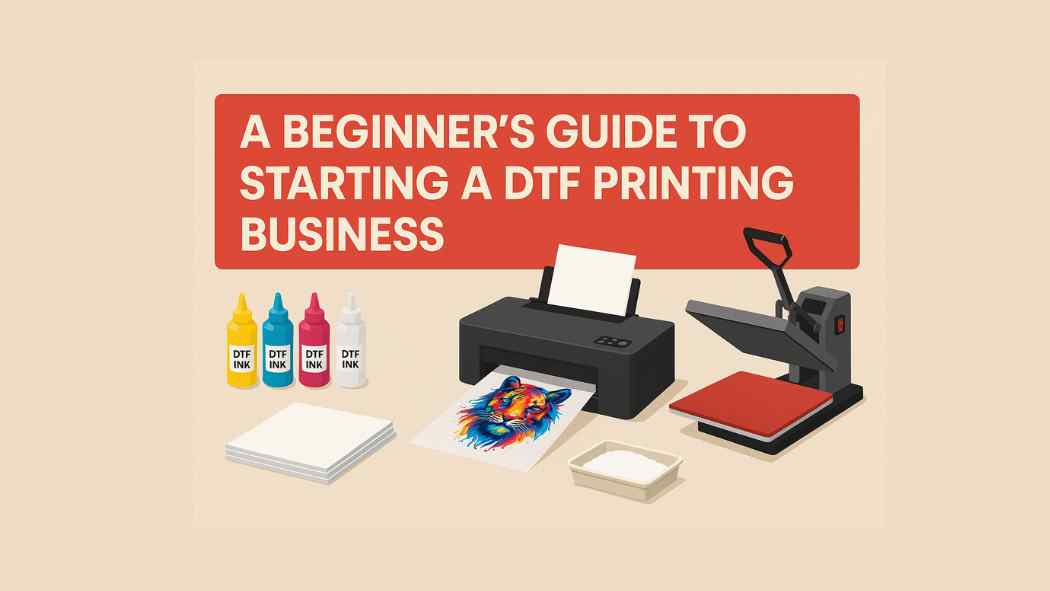A Beginner’s Guide to Starting a DTF Printing Business

DTF printing, or Direct-to-Film printing, is a popular method for creating custom designs on clothing and other items. It involves printing designs onto a special film, then transferring them to fabrics using heat. This guide is for beginners who want to start a DTF printing business. We’ll cover the basics, from understanding the process to setting up your operation and marketing your services. By the end, you’ll have a clear plan to get started.
What Is DTF Printing?
DTF printing works by printing ink onto a thin film, adding a powder adhesive, and then using a heat press to transfer the design to materials like t-shirts, hoodies, or bags. It’s great for small businesses because it allows full-color prints on various fabrics, including cotton, polyester, and blends. Unlike other methods, DTF doesn’t need pre-treatment for dark fabrics, which saves time.
The process is simple: design your image on a computer, print it on film, apply powder, cure it, and press it onto the item. Results are durable, with designs that resist washing and cracking. This makes DTF ideal for custom apparel businesses.
Why Start a DTF Printing Business?
Starting a DTF business has many benefits. Demand for custom clothing is high, from team uniforms to personalized gifts. You can work from home with low startup costs compared to other printing methods. Profit margins are good—charge $10–$20 per shirt while costs are $2–$5 each.
It’s flexible too. Begin part-time and scale up as orders grow. No need for a big team; one person can handle most tasks. Plus, it’s creative—you get to design and produce unique items.
Equipment You Need
To start, gather the right tools. Focus on quality to avoid issues later.
DTF Printer
The core tool is a DTF printer. These are modified inkjet printers that use special DTF ink. For beginners on a budget, look for the best cheap DTF printer options. You can find reliable models at best cheap DTF printer. Entry-level printers cost $500–$1,500. Choose one with at least four colors (CMYK) plus white ink for vibrant prints on dark fabrics.
DTF Ink and Film
DTF ink is pigment-based and comes in bottles. A set costs $100–$200. DTF film is the transfer medium; buy rolls or sheets for $50–$100 per pack. Match them to your printer for best results.
Powder Shaker and Curing Oven
After printing, apply hot-melt powder to make the design sticky. A manual shaker is cheap ($50), but an automatic one ($300+) speeds things up. Then, cure the film in an oven or with a heat press. A small curing oven costs $100–$300.
Heat Press
This transfers the design. A swing-away or clamshell press works; get one at least 15×15 inches for shirts. Prices range from $150–$500. Look for digital controls for temperature and time.
Computer and Software
Use a basic computer with design software like Adobe Illustrator or free options like Inkscape. RIP software (like AcroRIP) optimizes prints and costs $50–$200.
Other Supplies
Stock blanks like t-shirts ($2–$5 each), heat-resistant tape, and scissors. Total startup equipment cost: $1,000–$3,000.
Setting Up Your Workspace
A good setup ensures smooth operations. You need about 100 square feet, like a garage or spare room.
- Organize Layout: Place your printer near the computer. Keep the heat press in a ventilated area to handle fumes.
- Safety Measures: Use gloves for powder and ink. Have good lighting and ventilation fans.
- Storage: Keep supplies dry and organized in shelves or bins.
- Power and Internet: Ensure stable power outlets and Wi-Fi for orders.
Test your setup with sample prints to fix any issues early.
Learning the DTF Process
Master the steps before taking orders.
Step 1: Design Creation
Use software to make or edit designs. Keep resolution high (300 DPI) for sharp prints. Size designs to fit items, like 10×12 inches for adult shirts.
Step 2: Printing on Film
Load film into the printer. Set software to mirror the image and print in high quality. White ink goes first for base layer.
Step 3: Apply Powder
Shake powder evenly over the wet ink. Shake off excess. This step makes the design adhesive.
Step 4: Curing
Heat the film at 300–350°F for 2–3 minutes to melt the powder. Use an oven or heat press.
Step 5: Transfer
Place the film on the item, design down. Press at 320–350°F for 10–15 seconds with medium pressure. Peel the film while hot or after cooling, depending on the type.
Step 6: Finishing
Let the item cool. Check for adhesion; repress if needed.
Practice on scrap fabric to perfect timings.
Sourcing Materials
Buy in bulk to cut costs. Suppliers like Amazon or specialty sites offer DTF film and ink. For equipment, check reliable vendors. Visit https://www.dtflinko.com/ for a range of DTF products. Compare prices and read reviews. Start small, then find wholesale deals as you grow.
Legal and Business Basics
Set up properly to avoid problems.
Register your business as a sole proprietor or LLC. Get a business license if required in your area. Use free tools like Etsy or Shopify for an online store. Track expenses for taxes—deduct equipment and supplies.
Price services: Add material costs, time, and profit. For example, $15 for a basic t-shirt print.
Marketing Your Business
Get customers to grow.
Online Presence
Build a website or use social media like Instagram to show your work. Post before-and-after photos.
Local Outreach
Attend craft fairs or partner with schools for uniforms. Offer discounts to first customers.
Customer Service
Respond fast to inquiries. Provide samples to build trust.
Aim for word-of-mouth growth.
Common Challenges and Solutions
Ink clogs: Clean printer heads weekly.
Poor adhesion: Check temperature and pressure.
Faded colors: Use quality ink and calibrate software.
Scale slowly to manage issues.
Scaling Your Business
Once steady, expand. Hire help for orders. Add services like embroidery. Invest in bigger printers for volume.
Track profits monthly. Reinvest in marketing.
Final Thoughts
Starting a DTF printing business is straightforward with the right plan. Get equipment, learn the process, set up legally, and market actively. It’s rewarding to see your designs on products people love. Begin small, learn from mistakes, and build from there. With effort, you can turn this into a full-time income.



